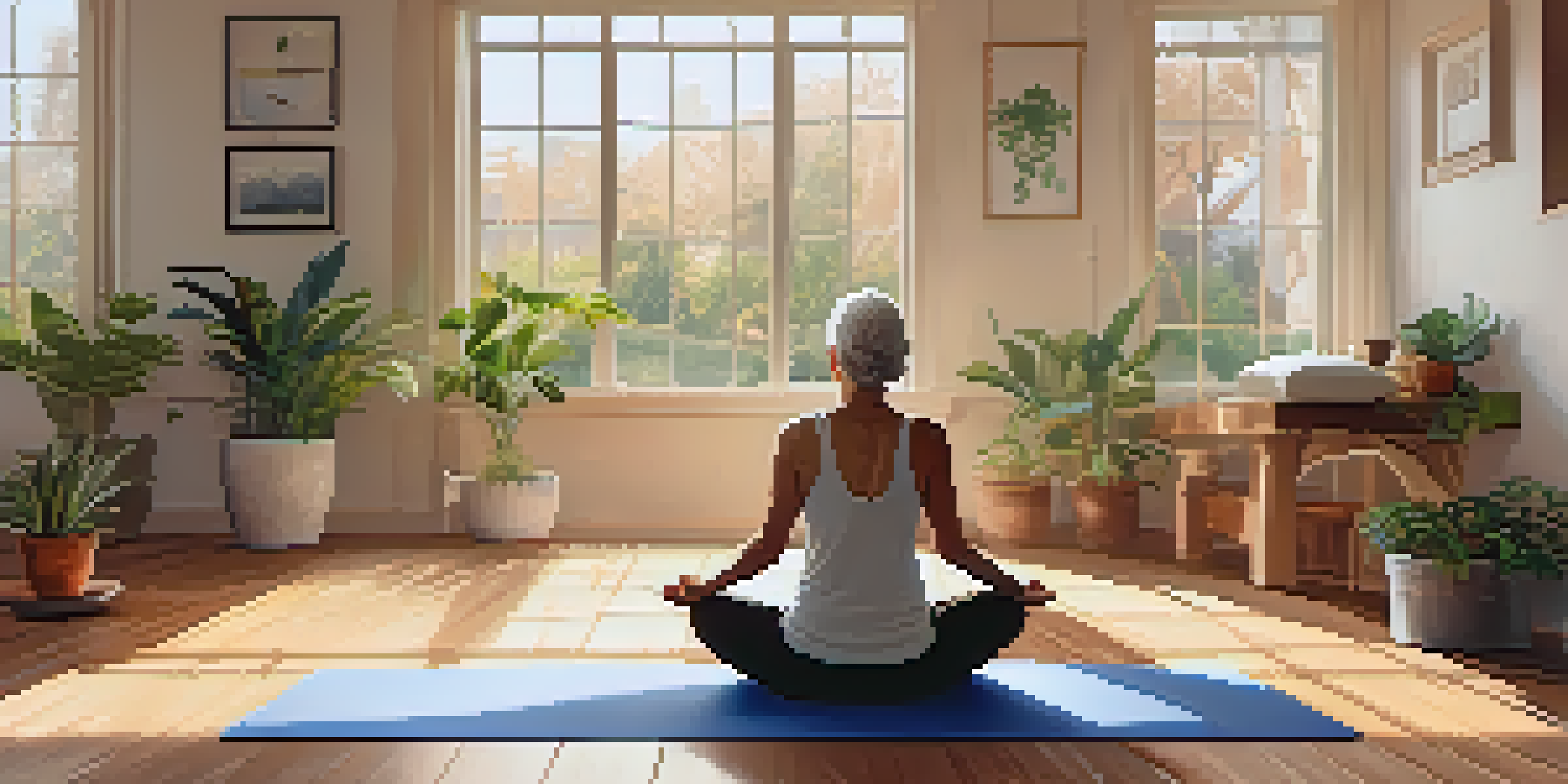Yoga for Joint Pain Relief: Gentle Practices for Aging Adults

Understanding Joint Pain in Aging Adults
As we age, our joints can become stiff and painful due to various factors like arthritis or wear and tear. This discomfort can limit mobility and affect daily activities, making it essential to find effective relief methods. Understanding the causes of joint pain helps in addressing it with appropriate practices like yoga.
Yoga is the journey of the self, through the self, to the self.
Joint pain often stems from inflammation, overuse, or injury, leading to conditions such as osteoarthritis. These issues can manifest as swelling, tenderness, or decreased range of motion in the affected joints. Recognizing these symptoms allows individuals to seek suitable exercises that promote healing and flexibility.
Yoga stands out as a gentle yet effective approach to managing joint pain. It emphasizes slow movements and deep breathing, which can enhance circulation and reduce stiffness. This holistic practice not only addresses physical discomfort but also nurtures mental well-being.
The Benefits of Yoga for Joint Health
Yoga offers a multitude of benefits for joint health, including improved flexibility, strength, and balance. By gently stretching and strengthening the muscles around the joints, yoga can help alleviate pain and prevent further injury. This makes it an ideal practice for aging adults looking to maintain their mobility.

Moreover, yoga encourages mindfulness and relaxation, which can significantly reduce the perception of pain. As individuals focus on their breath and movements, they often find that their discomfort lessens. This mental shift can be just as important as the physical aspects of yoga.
Yoga Eases Joint Pain
Gentle yoga practices can improve flexibility and reduce discomfort for aging adults experiencing joint pain.
In addition to physical benefits, many people report enhanced emotional well-being through regular yoga practice. The sense of community in yoga classes also provides social support, which is invaluable for those dealing with chronic pain. Together, these benefits create a comprehensive approach to joint health.
Gentle Yoga Poses to Relieve Joint Pain
Certain yoga poses are particularly beneficial for relieving joint pain, such as Child’s Pose, Cat-Cow, and Seated Forward Bend. These gentle stretches help to open up the hips, back, and shoulders, promoting greater flexibility. Practicing these poses regularly can lead to significant improvements in joint comfort.
The mind is everything. What you think you become.
Child’s Pose is excellent for stretching the lower back while providing a gentle release for the knees. Meanwhile, Cat-Cow helps to mobilize the spine, which can alleviate tension throughout the body. Incorporating these poses into your routine can create a positive impact on overall joint health.
It's important to listen to your body while practicing these poses. Modifications can be made to ensure comfort and safety, allowing everyone to benefit from yoga, regardless of their flexibility or experience level. Always remember, gentle movements are key.
Breathwork: Enhancing Your Yoga Practice
Breathwork, or pranayama, is an integral part of yoga that can greatly enhance the experience. Focusing on deep, intentional breathing helps calm the nervous system and reduces stress, which is often linked to pain perception. By incorporating breathwork into your practice, you can create a deeper sense of relaxation and relief.
For instance, practicing the 4-7-8 technique—inhale for four counts, hold for seven, and exhale for eight—can help ground your mind and body. This method not only aids in relaxation but can also distract from discomfort. Integrating such techniques can transform a typical yoga session into a powerful healing experience.
Listen to Your Body
Honoring your body's signals during yoga helps prevent injuries and fosters a positive relationship with movement.
Additionally, combining breathwork with gentle poses amplifies their benefits. As you move through each pose, coordinating your breath with your movements can set a calming rhythm, making the practice even more effective. This holistic approach fosters a deeper connection between body and mind.
Setting Up a Comfortable Yoga Space
Creating a comfortable yoga space is essential for an enjoyable practice, especially for those dealing with joint pain. Choose a quiet spot with enough room to move freely and ensure that it's comfortable underfoot. Using a yoga mat or soft surface can provide the necessary cushioning for your joints.
Consider adding props such as cushions, blocks, or straps to support your practice. These tools can make poses more accessible and comfortable, allowing you to focus on your breath and movement without strain. Personalizing your space with calming elements like plants or soft lighting can further enhance your experience.
Lastly, make sure to dress in loose, comfortable clothing that allows for easy movement. Ensuring your environment is conducive to relaxation will create a welcoming atmosphere that encourages you to practice regularly. A dedicated space can make all the difference in maintaining a consistent yoga routine.
Listening to Your Body: A Key Principle
One of the most important principles of practicing yoga for joint pain is to listen to your body. Everyone's level of comfort and flexibility is different, and it's crucial to honor those differences. If a pose feels uncomfortable or painful, it's perfectly okay to modify it or skip it altogether.
This principle encourages a more intuitive approach to yoga, fostering self-awareness and acceptance. By tuning in to your body’s signals, you can navigate your practice more safely. This not only helps prevent injuries but also cultivates a more positive relationship with movement.
Consult Your Healthcare Provider
It's important to seek professional advice before starting yoga, ensuring a safe and effective practice tailored to your needs.
Remember, yoga is a personal journey, and it's essential to progress at your own pace. Celebrate small victories, whether it's holding a pose longer or simply feeling less pain. Every step forward is a testament to your commitment to better joint health.
Consulting with Healthcare Professionals
Before starting any new exercise routine, especially for joint pain, it's advisable to consult with a healthcare professional. They can provide guidance tailored to your specific condition, ensuring that your yoga practice is safe and effective. This is particularly important if you have pre-existing health issues.
Healthcare providers can recommend specific poses or modifications that cater to your needs. They may also suggest working with a qualified yoga instructor who specializes in therapeutic yoga for seniors. Having professional guidance can enhance your practice and provide additional reassurance.

Incorporating yoga into your pain management plan alongside medical advice can lead to a more holistic approach to health. This collaboration between yoga and traditional healthcare can ultimately empower you to take charge of your well-being. Your journey towards joint pain relief can be both enriching and effective.